The title of the film conveys the dual meaning of the word—as both an accounting and a reverberant or explosive signal, echo or announcement of an event—and the film carries its full freight. The actual fragments of live radio broadcast transmissions that comprise the soundtrack are an accompaniment as much as reportage in the conventional sense. This is an accounting the artist makes first to himself—a revisiting of a traumatic break, or more precisely a sustained moment or sequence of traumatic fracturing. The ‘report’ is itself fractured and dissected into pyrotechnic sequences of ceremony, confusion, distress, panic, emergency, mobilization, death, cruelty, chaos, catastrophe. The whole of the film is a kind of recapture and resynthesis of what is both an emotional and cultural trauma.
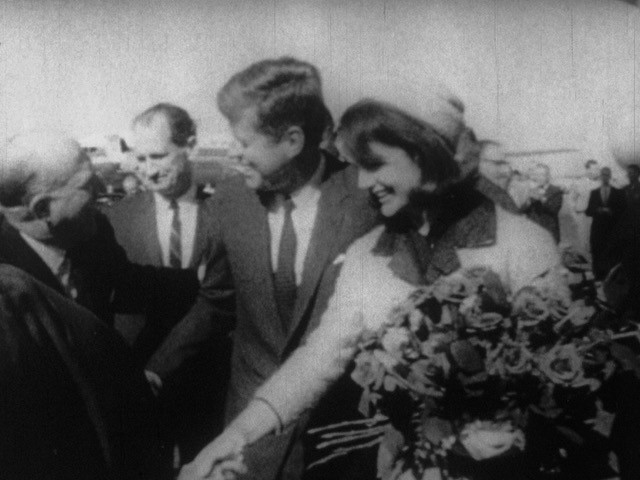 The subject event is the 1963 assassination of President John F. Kennedy and events that followed over the succeeding three days, covered almost continuously by live broadcast radio and television from the moment Air Force One landed in Dallas, and unfolding in real time for a national broadcast audience that at certain intervals might easily have encompassed half the country’s population, and a global audience perhaps no less sizeable from Siberia to Tierra del Fuego. The psychological and political trauma was real, and—with the exception of pockets of extreme right-wing fringe sects—was shared by a broad cross-section of the country’s political mainstream. Washington Post columnist Mary McGrory famously sighed to the future Presidential counsellor and New York Senator, Daniel Patrick Moynihan that “we’ll never laugh again.” But they did and so did the rest of the country—although within a couple of years political violence would return on an ever larger scale.
The subject event is the 1963 assassination of President John F. Kennedy and events that followed over the succeeding three days, covered almost continuously by live broadcast radio and television from the moment Air Force One landed in Dallas, and unfolding in real time for a national broadcast audience that at certain intervals might easily have encompassed half the country’s population, and a global audience perhaps no less sizeable from Siberia to Tierra del Fuego. The psychological and political trauma was real, and—with the exception of pockets of extreme right-wing fringe sects—was shared by a broad cross-section of the country’s political mainstream. Washington Post columnist Mary McGrory famously sighed to the future Presidential counsellor and New York Senator, Daniel Patrick Moynihan that “we’ll never laugh again.” But they did and so did the rest of the country—although within a couple of years political violence would return on an ever larger scale.
What the country and much of the Western world would not recover from was a kind radiation sickness induced by the immersive bath of virtually non-stop electronic broadcast media. Part of this was simply coincidental—the assassination happened on a Friday afternoon as some part of the country was already winding down to the week-end—the week-end preceding the Thanksgiving week-end that would follow. Half the country was in a state of shock. Retreating home under the impact of this blow, there was little resistance to sitting as a captive audience to developments through the week-end. The State funeral was set for the following Monday, which was declared a national day of mourning. You would be witnessing history simply by tuning in to network coverage. And the audience was prepared: the coverage of American involvement in Vietnam and the unstable regimes the U.S. government was trying to prop up was already filtering into American living rooms.
It might have served as a preview for a network television series that debuted that very season, the intro to which began, “There is nothing wrong with your television. Do not attempt to adjust the picture. For the next hour, we will control the horizontal. We will control the vertical,…” and so on. Televisions flickered on early in the morning and stayed on until local affiliates shut down. The flight back to Washington; Jackie jumping to the tarmac in her blood-stained Chanel suit; the funeral procession with its phalanx of world leaders; the riderless horse; John-John saluting; the perpetual flame at Arlington; and—oh yeah—depending upon how you timed it, the murder of the accused assassin, Lee Harvey Oswald by a Dallas nightclub owner, Jack Ruby, on live television. (This was before children typically exclaimed “What the fuck?” in polite company.) And many of these news items and images played over and over from one major network to the next. It was not coincidental that Andy Warhol would single out many of those iconic images of Jackie to be configured in repeating grids and arrays: Jackie at Love Field; Jackie in the fatally open presidential limo; Jackie climbing back over the Lincoln’s trunk; Jackie at Parkland Hospital; Jackie on Air Force One witnessing Lyndon Johnson being sworn in; Jackie on the tarmac at Andrews Air Force Base; a black-veiled Jackie at Arlington.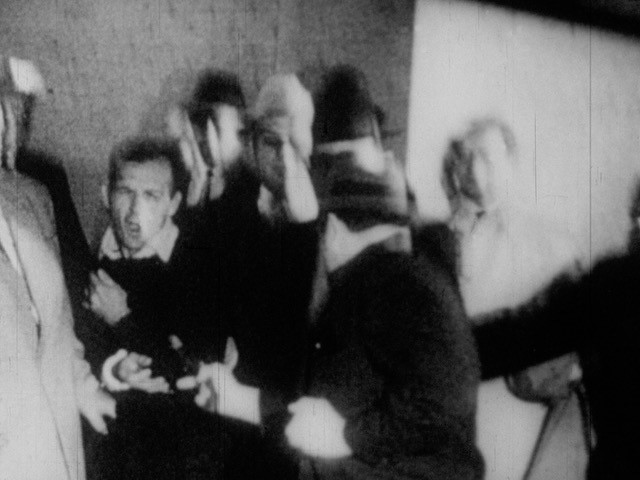
We are still trapped with these images, and the history that precedes them. (And succeeds them: millennials will always have the burning and collapse of the World Trade Center towers, the spiraling aircraft, the falling bodies.) Here, as in the classic A Movie, Conner uses film leader as a kind of respiratory and rhythmic device alternating in anticipation and apprehension—safe to exhale there; don’t breathe here; catch your breath—just about nowhere. We are counting down; we are counting towards. Panic and desperation are the givens. At certain critical intervals, the screen fades to shadowy gray or in one instance white with the leader gone clear for 16 frames or so—as if fainting; not a loss of consciousness, but a momentary suspension of belief; a moment of denial, escape, erasure. It’s a ‘fog of war’ that obscures the horror he has witnessed, the further horrors to be anticipated.
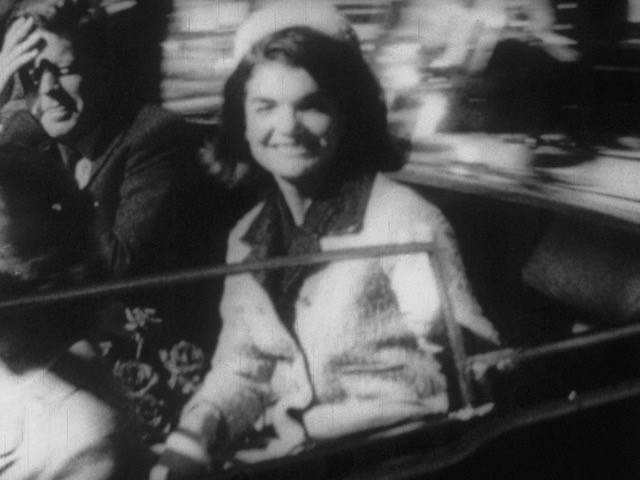 The film alternately rushes toward us and past or away from us in staggered, repeated segments. Events move in and upon us quickly and brush past with a gesture or glint of sunlight or television lights or a camera flash. Conner parks us before the on-coming open Lincoln stretch limousine that was the designated presidential vehicle in Dallas. (The color of the vehicle, we are reminded by one of the contemporaneous radio announcers on the soundtrack is “gun-metal gray.”) The grille catches the sun, flags flap, helmeted motorcycle cops flank the car, then Jackie smiling, without sunglasses; and the car angles around a slight bend and the President is seen half saluting, half brushing hair from his eyes; finally the rear of the vehicle and the follow-up car filled with Secret Service agents. Conner repeats and reverses the angle of the footage from left to right and back over a fragment of the local radio broadcast that jumps ahead of the motorcade footage to its sudden slowing and interruption as the first shot is registered and Secret Service agents move on the vehicle. The screen suddenly fades to gray as the radio announcer on the soundtrack begins to relay increasingly ominous information. A gunshot wound is confirmed, the motorcade detours to nearby Parkland Hospital, and the screen seems to mirror the accelerating vibration of the announcer’s vocal chords. As the motorcade picks up speed toward Parkland, we hear the urgency in the announcer’s voice and the undulating dark waves give way to a bright strobing effect—a visualization of panic but also a kind of recapitulation of incidents already swept by and anticipation of events to come—not unprinted leader, but bleached or overexposed narrative footage that might once have featured moving objects, human subjects or physical landscape, its scratches throwing up dark sparks onto the screen. The strobing gradually darkens to a point where we might be moving through a dark wind tunnel towards an even darker wash of movement we scarcely dare speculate about. The film (and Parkland coverage) abruptly stops on a white screen, but within a moment, the soundtrack resumes (to the Texas School Book Depository)—now beneath the parading of the assassination weapon, an Italian carbine with telescopic sight—and the film speeds ahead of the live confirmation of Kennedy’s demise: Jackie trying to open an ambulance door at Love Field (over and over). And the nightmare repeats as a secondary witness account is heard.
The film alternately rushes toward us and past or away from us in staggered, repeated segments. Events move in and upon us quickly and brush past with a gesture or glint of sunlight or television lights or a camera flash. Conner parks us before the on-coming open Lincoln stretch limousine that was the designated presidential vehicle in Dallas. (The color of the vehicle, we are reminded by one of the contemporaneous radio announcers on the soundtrack is “gun-metal gray.”) The grille catches the sun, flags flap, helmeted motorcycle cops flank the car, then Jackie smiling, without sunglasses; and the car angles around a slight bend and the President is seen half saluting, half brushing hair from his eyes; finally the rear of the vehicle and the follow-up car filled with Secret Service agents. Conner repeats and reverses the angle of the footage from left to right and back over a fragment of the local radio broadcast that jumps ahead of the motorcade footage to its sudden slowing and interruption as the first shot is registered and Secret Service agents move on the vehicle. The screen suddenly fades to gray as the radio announcer on the soundtrack begins to relay increasingly ominous information. A gunshot wound is confirmed, the motorcade detours to nearby Parkland Hospital, and the screen seems to mirror the accelerating vibration of the announcer’s vocal chords. As the motorcade picks up speed toward Parkland, we hear the urgency in the announcer’s voice and the undulating dark waves give way to a bright strobing effect—a visualization of panic but also a kind of recapitulation of incidents already swept by and anticipation of events to come—not unprinted leader, but bleached or overexposed narrative footage that might once have featured moving objects, human subjects or physical landscape, its scratches throwing up dark sparks onto the screen. The strobing gradually darkens to a point where we might be moving through a dark wind tunnel towards an even darker wash of movement we scarcely dare speculate about. The film (and Parkland coverage) abruptly stops on a white screen, but within a moment, the soundtrack resumes (to the Texas School Book Depository)—now beneath the parading of the assassination weapon, an Italian carbine with telescopic sight—and the film speeds ahead of the live confirmation of Kennedy’s demise: Jackie trying to open an ambulance door at Love Field (over and over). And the nightmare repeats as a secondary witness account is heard.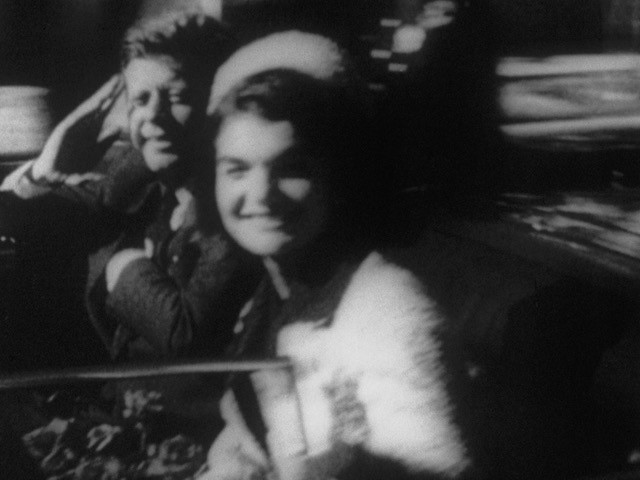
Conner fixates on moments like these. We can’t seem to open the ‘ambulance door’, nor can we seem to close it—can’t deliver the wounded to a place of safety, can’t acknowledge an event’s terminus. Of greater significance and urgency, however, is that the images themselves, however horrific or anticipatory of horror, are re-shaped, as if by hammering, into a mechanism of denial or a kind of anesthesia. The image or gesture was once there and will always be there, notwithstanding the fact that its instigator has abruptly been deleted from the altered, consequential actuality.
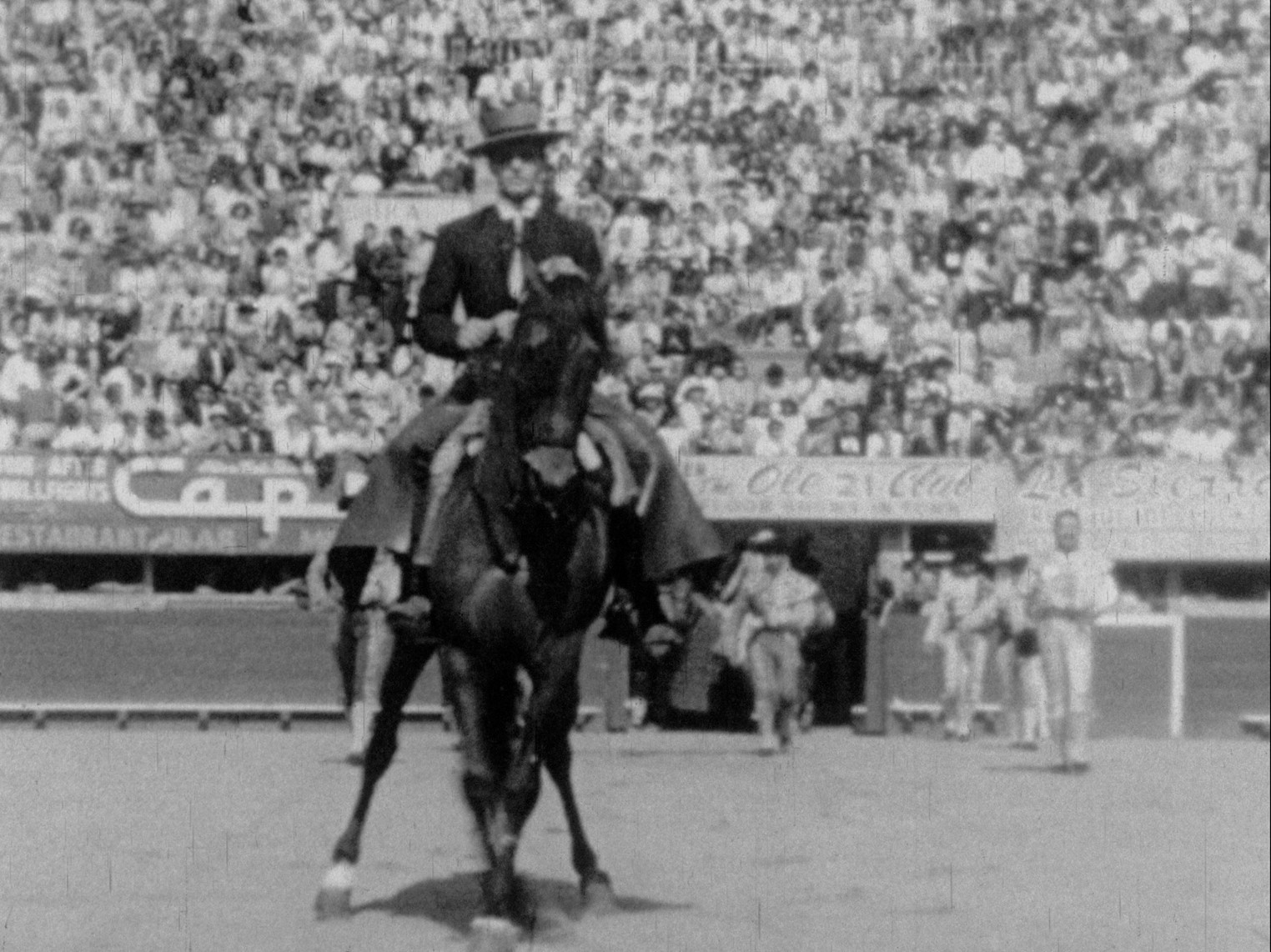 Over another radio commentary, a stretch of leader takes us to an extended montage of contemporaneous newsreel and television advertising images that echo the broadcast’s narrative details, including extensive clips from a Spanish bullfight, replete with ceremony and stunning cruelty. A mounted picador dances his horse through a bullfight arena and raises his hat to the spectators to open the spectacle. The bullfight footage is broken alternately by clips in a flashback/flash-forward rhythm from a Kennedy state visit (with the Pope) to his funeral mass. The juxtapositions are both startling and ironic. (The “doors (of the Presidential aircraft) fly open” as refrigerator doors ‘fly open’ to a woman’s apparent delight; and another shot zooms in on a Tappan “Food Waste” disposer. In another a man attempts to mount an American flag on a power line, while a mauled matador is rescued from a tormented bull. A nuclear test mushroom cloud rises on “we have a brilliant sun.”) The sleek, self-contained, and self-possessed give way to decay and entropy. The imagery becomes progressively darker and (literally) more explosive. Conner is occasionally heavy-handed, almost obvious (a bullet shattering a lightbulb; a pin bursting a bubble). But this is subsumed within a larger refusal—the ‘darkness visible’ domain of ‘Camelot Lost’, the merciless sacrifice, the graceless ‘coup de grâce’. Conner declines to simply churn the repeating nightmare, to relegate these indelible gestures to the domain of Buñuelian surrealism. There’s an exasperation here, not with a ‘drowning’ of ‘ceremony’ (no one is innocent here; everyone is implicated), but with a barbarism forever cloaked in ceremony and sanctimony.
Over another radio commentary, a stretch of leader takes us to an extended montage of contemporaneous newsreel and television advertising images that echo the broadcast’s narrative details, including extensive clips from a Spanish bullfight, replete with ceremony and stunning cruelty. A mounted picador dances his horse through a bullfight arena and raises his hat to the spectators to open the spectacle. The bullfight footage is broken alternately by clips in a flashback/flash-forward rhythm from a Kennedy state visit (with the Pope) to his funeral mass. The juxtapositions are both startling and ironic. (The “doors (of the Presidential aircraft) fly open” as refrigerator doors ‘fly open’ to a woman’s apparent delight; and another shot zooms in on a Tappan “Food Waste” disposer. In another a man attempts to mount an American flag on a power line, while a mauled matador is rescued from a tormented bull. A nuclear test mushroom cloud rises on “we have a brilliant sun.”) The sleek, self-contained, and self-possessed give way to decay and entropy. The imagery becomes progressively darker and (literally) more explosive. Conner is occasionally heavy-handed, almost obvious (a bullet shattering a lightbulb; a pin bursting a bubble). But this is subsumed within a larger refusal—the ‘darkness visible’ domain of ‘Camelot Lost’, the merciless sacrifice, the graceless ‘coup de grâce’. Conner declines to simply churn the repeating nightmare, to relegate these indelible gestures to the domain of Buñuelian surrealism. There’s an exasperation here, not with a ‘drowning’ of ‘ceremony’ (no one is innocent here; everyone is implicated), but with a barbarism forever cloaked in ceremony and sanctimony.
The film closes on a cool, cynical note—an agent at what seems to be a ticketing agency coolly pressing a key to ‘SELL’ a theatre seat. Another seat to the spectacle sold.
Like many (if not most) of Bruce Conner’s films, REPORT is in black-and-white, which is appropriate on many levels. There was substantial color photography of the Dallas presidential trip—and it’s impossible to forget that the Abraham Zapruder film that accurately captured the assassination moment-by-moment was in color. But much of the network news coverage of the assassination and ensuing events was in black-and-white and even some of the color coverage was transmitted and ultimately broadcast in black-and-white. (Also much of the audience would have only seen black-and-white coverage because they had black-and-white rather than color television units.) Irrespective of the technical (and/or timing) reasons for this, it remains true to the moment now as much as it was then. It was a series of events that, for those outside of that ‘Camelot’ circle, was very much experienced in shadow, and it remains in shadow.
In the weeks that followed the assassination, as newspaper front pages moved on, national magazines weighed in with special issues, pictorials, and memorials, book deals were struck, the Warren Commission (headed by then Chief Justice Earl Warren) convened to investigate, Jackie laid out the groundwork for the “Camelot” mythology to be engineered by Theodore H. White for Life Magazine, and commissioned William Manchester to write a book about the President’s death—with which she would later have a few issues. Manchester was not a historian easily disposed to sanctimonious convention. The book was published, but she litigated (successfully) for some changes to the text.
The country had already moved on. January 1964 beckoned and the new President actually looked to consolidate a winning Democratic legislative agenda. The ‘torch’ would indeed ‘be passed’ to this generation—but not actually the President’s. The following month, an English rock’n’roll band would make its New York and nationwide network broadcast debut on The Ed Sullivan Show. And with The Beatles, the British Invasion had begun; so had a new media culture.
The media culture of the 21st century is far more fragmented that the 20th century’s, which until the late 1990s still shared certain commonalities across diverse social, cultural, economic, and political divides. Now those commonalities have withered as diverse audiences cultivate very specific tastes, tailored to specific biases, and chase their independently cultivated enthusiasms down a bewildering array of algorithmic corridors tailored to their desires (as apprehended and interpreted by the same algorithms). Some portion of those audiences seem to live all but continuously in a shadowy, flickering, half-lit domain; while some other portion of us remain all but deafened by an endlessly repeating, reverberating, even deafening ‘report’. We’re still drowning in ceremony; and we’re still processing.
REPORT, a film by Bruce Conner — Kohn Gallery, 1227 N. Highland Ave., Hollywood — through June 25, 2022


